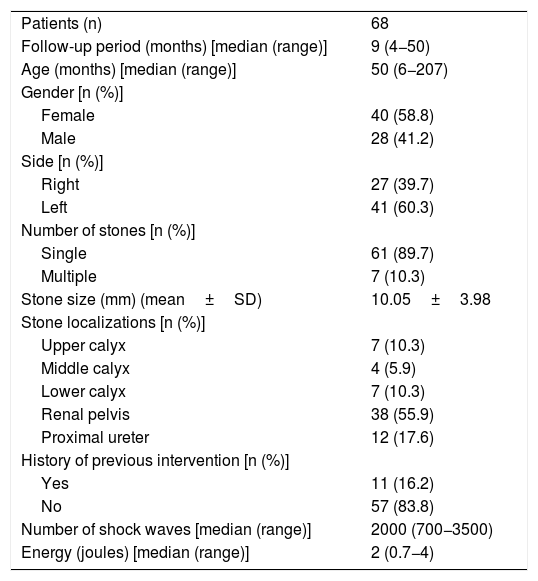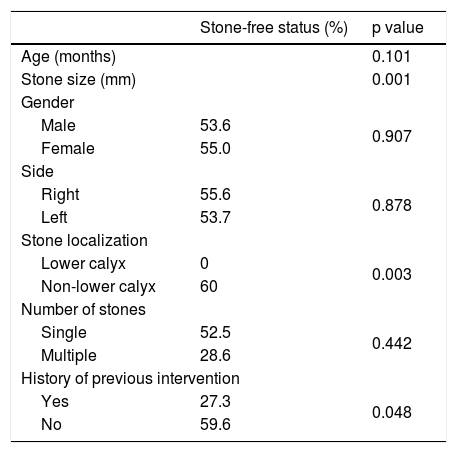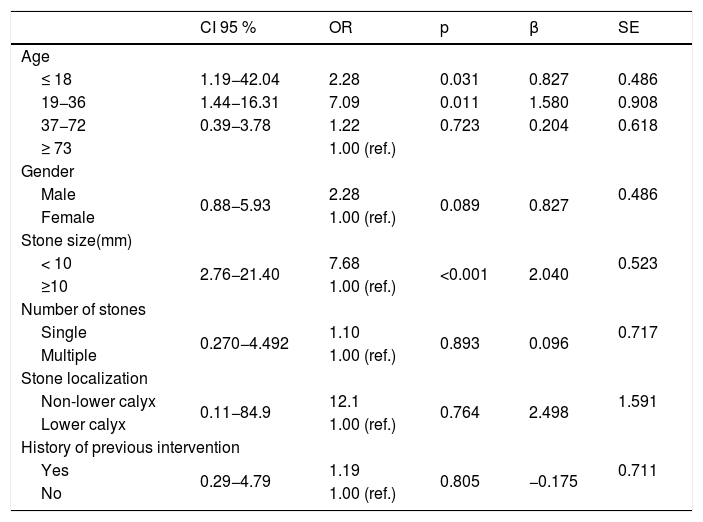To evaluate the accuracy of the Dogan nomogram in predicting stone-free (SF) rate after a single shock wave lithotripsy (SWL) session and evaluate factors that predict SWL results in children.
Patients and methodsThe study included 68 patients under 18 years of age who had been treated with SWL for radiopaque upper urinary tract stones in our tertiary centre from January 2010 to December 2016. The median age is 50(6-207) months and median follow-up period is 9(4-50) months. Patients with known cystine stone disease, abnormal renal anatomy, urinary diversion and multiple stones located in different calyces were excluded like in the original nomogram study. SF status was evaluated by performing plain abdominal radiography and urinary ultrasonography (US) two weeks after each SWL session. Patients who were completely free of stones were considered to be SF. Multiple logistic regression analyses were performed to determine the variables affecting SF status. The bootstrap method with 1000 replicates was used for the external validity of a nomogram developed by Dogan et al.
ResultsSF rates for each SWL session were determined as 54.4% (37/68) for the first session, 33.3% (7/21) for the second session and 55.6% (5/9) for the third session. Overall, the SF rate was 72.1% (49/68). Multiple logistic regression analysis showed positive and significant correlations of age and stone size with risk of SWL failure. The external calibration plot showed a nearly good validation with Dogan nomogram to predict SWL failure in first session.
ConclusionOur study demonstrates that the Dogan nomogram can be used to predict the stone-free status after one session of SWL in pediatric patients.
Evaluar la exactitud del nomograma de Dogan para predecir la tasa libre de cálculos (LC) tras una única sesión de litotricia por ondas de choque (LEOCH) y evaluar factores predictivos de los resultados de LEOCH en niños.
Pacientes y métodosEn el estudio participaron 68 pacientes menores de 18 años que habían sido tratados, en nuestro centro terciario desde enero de 2010 hasta diciembre de 2016, con LEOCH por cálculos radiopacos del tracto urinario superior. La media de edad fue de 50 meses (6-207) y la media del período de seguimiento de 9 meses (4-50). Se excluyeron los pacientes con litiasis cistínica, anomalía renal, derivación urinaria y litiasis múltiples localizadas en diferentes cálices, igual que en el estudio del nomograma original. El estatus LC se evaluó mediante la realización de radiografía simple de abdomen y ecografía urinaria (ECO) dos semanas después de cada sesión de LEOCH. Los pacientes que estaban completamente libres de cálculos fueron considerados LC. Se realizaron análisis de regresión logística múltiple para determinar las variables que afectan el estado de LC. El método bootstrap con 1000 repeticiones se utilizó para la validación externa del nomograma desarrollado por Dogan et al.
ResultadosLas tasas de LC para cada sesión de LEOCH fueron de 54.4% (37/68) para la primera sesión, 33.3% (7/21) para la segunda sesión y 55.6% (5/9) para la tercera sesión. En total, la tasa de LC fue del 72.1% (49/68). El análisis de regresión logística múltiple mostró correlaciones positivas y significativas entre la edad y el tamaño del cálculo con el riesgo de fracaso al tratamiento con LEOCH. El gráfico de calibración externa mostró una validación aceptable respecto al nomograma de Dogan para predecir el fracaso de LEOCH en la primera sesión.
ConclusiónNuestro estudio demostró que el nomograma de Dogan se puede utilizar para predecir el estado libre de cálculos tras una sesión de LEOCH en pacientes pediátricos.











